

 The South African
The South African
Scheepers rode into the Cape Colony... self-confident and a complex person. (Shearing, 1999, p33)
Few stories of the Anglo-Boer War have captured the public imagination quite as much as that of Gideon Scheepers, sentenced to death and executed by a British firing squad on 18 January 1902. This article examines the proceedings of the court case; Scheepers is popularly held to have been wrongly accused of the crimes that sent him to his death.
Introduction
Gideon Scheepers entered the Cape Colony with Commandant P H Kritzinger's commando on 16 December 1900. He carried out his first attack 30 December, with the capture and burning of a train at Sherborne, as a result of which one soldier died of wounds. His subsequent, action-packed timeline reads:
02-01-1901: Skirmish at Grootvlei (near
Middelburg). One soldier dies of wounds.
11-01-1901: Action at Waterval, near
Middelburg. Six soldiers killed.
Uniondale, shops looted, telegraph
destroyed, records at the Magistrate’s
Court burned.
29-01-1901: Attack at Buffelsklip near
the Wilge River. Two soldiers killed.
Scheepers begins to operate
independently.
11-02-1901: Klaarstroom attacked, post
office and telegraph destroyed,
government stores looted. Two soldiers
killed. Action at Kaffersfontein. Men of
DMT captured, held as prisoners of war
for two weeks.
26-02-1901: Towerwaterspoort,
Uniondale District, attacked. Two
soldiers killed.
05-03-1901: Aberdeen occupied.
Bicycles destroyed and horses
commandeered. Two soldiers killed.
18-03-1901: Glendinning. One soldier
killed.
15-03-1901: Graaff-Reinet. Five
Georgehan Scouts killed.
15-03-1901: Uitkomst destroyed. A
certain Christian Smit (servant) is executed.
19-03-1901: Jansenville. In clash with
Colonial troops, three soldiers killed.
06-04-1901: Near Aberdeen, two soldiers
killed.
24-04-1901: Stockdale (owner H J
Moolman) destroyed.
05-05-1901: Clash with armed force at
Zwaggershoek. One soldier killed.
08-05-1901: Train derailed at Mortimer.
Stores looted at Pearston.
09-05-1901: Gannahoek, near Cradock.
One soldier killed.
10-05-1901: A certain Pieter Hugget is
given lashes.
12-05-1901: Clash at Quaggashoek near
Tarkastad. One soldier killed.
18-05-1901: Train ambushed at Marais
Siding and set ablaze.
21-05-1901: Col Scobell captures 21
men of Scheepers’ commando.
01-06-1901: Attacks Willowmore. Six of
Town Guard killed.
14-06-1901: Occupies Murraysburg.
Demands food from shopkeepers. Bank
manager Frank Lifford is assaulted.
27-06-1901: Again occupies Murraysburg. Ransacks town. School teachers
are assaulted.
06-07-1901: Murraysburg occupied
again. Public buildings and Sharwood’s
shop destroyed. Vleiplaas, owned by A J Herholdt, is
destroyed. Scheepers is attacked at
Ruggerskraal. Sets buildings ablaze at
Aberdeen Road Station.
14-07-1901: Camdeboo Mountain. One
soldier killed.
21-07-1901: Ganna Siding attacked.
Train looted. Three soldiers killed.
Uitkyk, owned by a Rabie, is burnt.
27-07-1901: Fonteinplaas, owned by a
Van Niekerk, is burnt. Scheepers drives
back elements of Willowmore District
Mounted Troops at Hartebeeskraal.
30-07-1901: Murraysburg. One soldier
is fatally wounded at Kareebosch.
04-08-1901: Aberdeen District: Glen
Doone and Featherstonehaugh are burnt.
Furniture looted.
06-08-1901: Const James Madlaila is shot
at Rooiklip near Steytlerville. Wanhoop,
Uniondale District: Boers under Piet van
der Merwe clash with 10th Hussars. One
soldier is killed.
16-08-1901: Misgund attacked by Van
der Merwe. Store and homestead
destroyed. Two soldiers killed.
19-08-1901 ff: Avontuur. Post office
and telegraph lines destroyed. Three
soldiers killed. One soldier killed near Uniondale.
Post office destroyed at Oudemuragie.
Farms destroyed at Wolwekraal,
Molen River, Dieprivier and Ezeljacht
by Van der Merwe. Keurbooms, The Willows in Knysna
district set ablaze. Lt Taute's farm
Molen River destroyed.
27-08-1901: Ladismith District. Van
der Merwe, being on a separate foray,
joins Scheepers at Knuy.
Scheepers announces he is sick.
Myskraal ransacked.
29-08-1901: Despatch riders, Petrus
Arendse and Pieter de Koch, receive
25 lashes each. Myskraal burnt.
Shop looted at Barrydale.
05-09-1901: Montagu. Scouts Jan
Jacpan, Johannes Rooy captured.
Both are executed by order from Van
der Merwe.
05-09-1901: Scout John Kennedy,
captured near De Fontein, is executed.
09-09-1901: Driefontein, Laingsburg
district. Clashes with Lt-Col Crabbe's
force. Van der Merwe and three Boers
killed. Crabbe loses five men killed.
22-09-1901: Clash with scouts near
Kamanassie River. One soldier killed.
23-09-1901: Post office at Schoemanshoek vandalised.
26-09-1901: Oudsthoorn District.
Scout Jacobus Hermanus is murdered
at Kruisrivier.
30-09-1901: Riversdale, Oudtshoorn
District. House Brandrivier of Jan Nel
burnt at Buffelsfontein. Two Oudtshoorn
Volunteer Guards killed.
Scout Jan Anhuizen is arrested by
Scheepers and given 25 lashes.
04-10-1901: Ladismith District:
Scheepers’ health begins to deteriorate.
He is unable to ride a horse and
henceforth uses a cart.
05-10-1901: Clash with Colonial
troops. One killed.
08-10-1901: Ladismith. The mail cart
is robbed.
Scheepers is attacked at Ruggerskraal.
11-10-1901: Scheepers is driven out
of Wolwefontein by a contingent of 10th
Hussars. He arrives at Koppieskraal. His
commando leaves him there.
Dr Mearns diagnoses Scheepers as
suffering from obstruction of the bowel
and appendicitis.
11-10-1901: Scheepers, now alone at
Koppieskraal, surrenders to Capt E R A
Shearman of the 10th Hussars.
12-10-1901: Scheepers is taken to
Blood River Station (now Anjes Siding),
then by train to Matjesfontein.
19-10-1901: He is transferred to
Beaufort West.
14-11-1901: Scheepers is transported
by train to Noupoort Military Hospital.
09-12-1901: Transported by train
to Graaff-Reinet for trial.
17-12-1901: The trial begins in
Graaff-Reinet. Scheepers faces 30
charges, including murder, arson
and mistreatment of prisoners of war.
Due to his illness, the trial is post-
poned to 27 December 1901.
27-12-1901: The trial continues.
17-01-1902: Pronounced guilty
and sentenced to death.
18-01-1902: Executed at 15:00 by
firing squad. Interred at the site of
execution. Later his body is
exhumed.
18-01-1902: Scheepers' body is
reburied, site unknown.
Sources and more information:
Pieter Cloete, Die Anglo-Boeroorlog: ’n Chronologie (2010)
Taffy & David Shearing, Commandant Gideon Scheepers
and the search for his grave (1999).
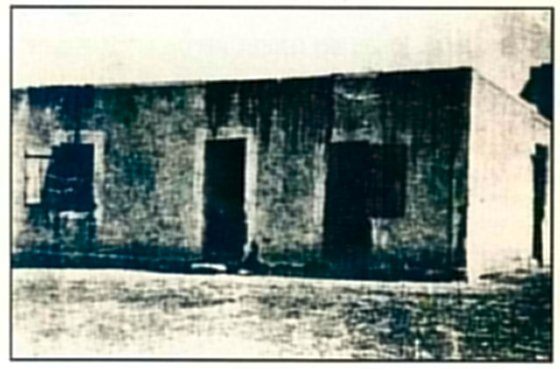
Koppieskraal, 1955.(Photo: Retief Koch).
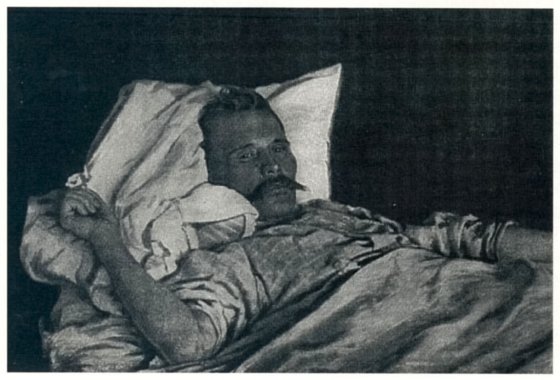
This photograph of Gideon Scheepers was most probably taken
while in hospital in Beaufort-West. (Source: Unknown).
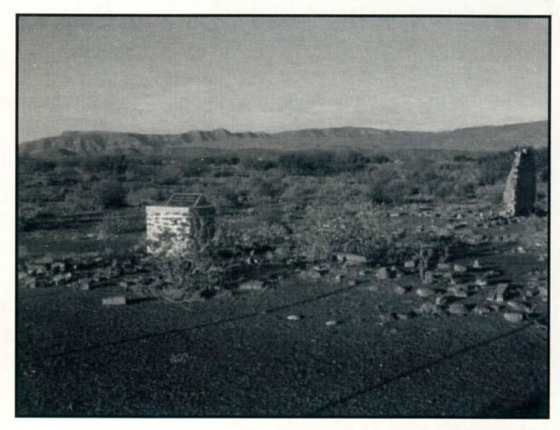
Koppieskraal, the site where Scheepers was captured.
All that remains of the original homestead is a wall.
A memorial has been erected to commemorate the site.
(Photo: Alan Duff).
Thirty Charges
While at Koppjeskraal, Dr J H Mearns diagnosed Scheepers’ condition as ‘obstruction of the bowel and appendicitis’ (Shearing, 1999, p141). He was hospitalised at Matjesfontein, Beaufort West and Noupoort. On 9 December, Scheepers travelled by train from Noupoort to Graaff-Reinet where, at the station, he was transferred to an ambulance wagon and taken to gaol. He was not put among ordinary prisoners but kept in a hospital room with bars over the windows. He was no longer a patient, but a prisoner on his own.
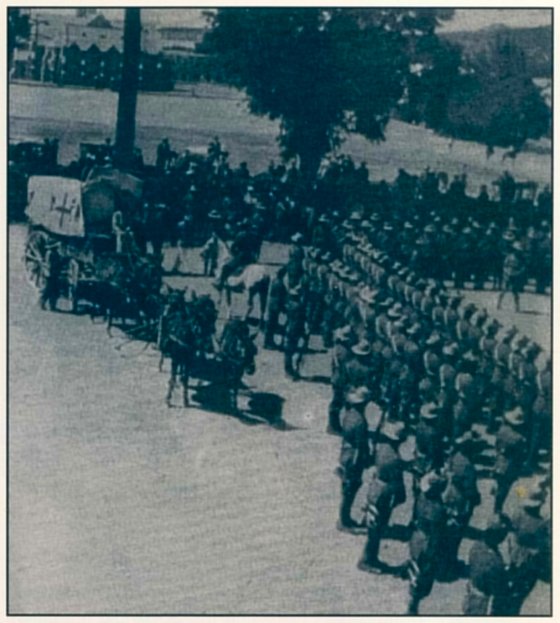
Gideon Scheepers arrives
by ambulance wagon at Church Square.
(Source: Unkown).
The court proceedings began on 17 December. For his defence, Scheepers chose Thomas Auret as his attorney. Scheepers pleaded not guilty to the entire indictment.
The first charge was about the deaths of Jacob Fillies and Kiedo, both of whom had been scouting on the orders of Herbert Sharwood. Scheepers was convicted of murder. (Shearing, 1999, p151)
The second charge related to the murder of a black policeman, Moyewka, near Willowmore (Shearing, 1999, p152). The third dealt with the murder of Christian Smit at Uitkomst in the Jansenville District, shot by a member of Scheepers’ commando. (Shearing, 1999, p152), and the fourth, with the killing of James Madlaila near Steytlerville (Shearing, 1999, p153). The 5th charge was for the murder of Jac Jacpan and Johannes Rooy near Wildefontein, Montagu, on 5 September. Piet van der Merwe (Scheepers’ deputy) had been present when the two men were shot; Scheepers had not. He was acquitted (Shearing, 1999, p154).
The 6th charge was for the murder of John Kennedy at De Fontein for allegedly being a spy. He had been shot. Scheepers was declared guilty of Kennedy’s death (Shearing, 1999, p155). The 7th charge had Scheepers accused of the killing of Jacobus Hermanus near Kruisrivier, Oudtshoorn on 26 September 1901. Again, he was found guilty (Shearing, 1999, p155). The 8th and 14th charges involved train wrecking at Marais Siding, where Scheepers was thought responsible of attempted murder. His men had removed articles from the train and set it ablaze. In his defence, Scheepers stated that he had instructed his men to destroy trains in order to commandeer the supplies. The 15th charge was for train wrecking at Marais Siding, which endangered His Majesty’s subjects. These charges were grouped with charges 9 and 10 (Shearing, 1999, p157).
The next three charges involved the flogging of workers. According to the 11th charge, Peter Huggett had been stretched over a ladder and became unconscious after the eighth stroke, while the 12th related to the double flogging of Goxo, who had been accused, firstly, of the death of a certain Lieutenant Swanepoel at Bo-Rietvlei, and, secondly, of allegedly reporting the presence of Boers to a British army unit (Shearing, 1999, p151). The 13th charge related to the beating of Jan Aanhuizen, who had been flogged at Buffelsfontein after he was about to join a British column. In his defence, Scheepers said that the man had been captured as a scout. Aanhuizen was given fifteen lashes (Shearing, 1999, p157).
The remainder of the charges included sixteen cases of arson. Herbert Sharwood gave evidence on the 20th charge, saying that, on 6 July 1901, his house was burnt down in Murraysburg.
Scheepers admitted to most of the arson charges: to burning Meredith’s homestead at Uitkomst (the 16th charge), Berrington’s homestead (17th), Stockdale (18th), the goods shed at Biesjes Poort at Beaufort West (the 19th), the house and store of Sharwood at Murraysburg (charge 20), the property of a certain Innes (charge 21), Vleiplaats, which belonged to A J Herholdt (charge 22), Aberdeen Railway Station and adjoining buildings (charge 23), Fonteinplaats, Aberdeen, the home of a certain Rabie (charge 24), the home of a Van der Merwe (charge 25), and Brand River, Riversdale, the homestead of Jan Nel (charge 30). (Shearing, 1999, pp159-160).
However, Scheepers pleaded not guilty to charges 26 to 29, that of burning down of Glen Doone, the homestead of S J Featherstone; Featherstonhaugh, belonging to David Featherstone; Stone’s Store at Misgund; and Van Niekerk’s home at Misgund, respectively.
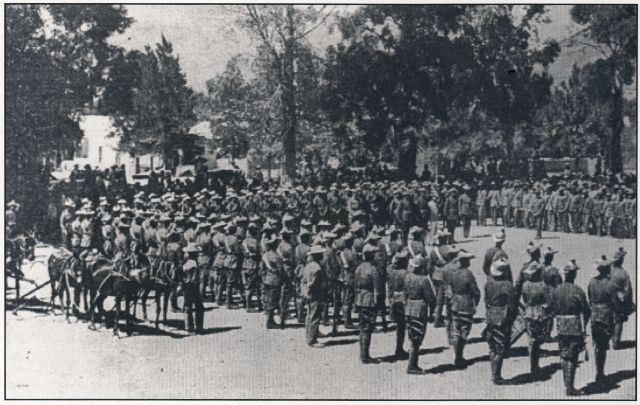
Promulgation of Scheepers’ death sentence on 17 January 1902.
The troops formed three sides of a square comprising the Coldstream Guards
and members of the Town Guard. Scheepers can be seen in white trousers in
the centre of the square. (Source: Illustrated London News).
The trial of Gideon Scheepers
The trial began on 18 December 1901 and evidence was led until the 22nd. The next day, Scheepers was too ill to attend. The court sat for two hours on 24 December before adjourning for Christmas (Shearing, 1999, pp159-160). It reconvened on 27 December after Scheepers had prepared for his defence. He declared he was a Free State burgher (and thus not a Cape rebel). He and his troops had entered the Cape Colony under General Christiaan de Wet’s command. A Krygsraad (Council of War) had been convened at which it was decided to give General Kitchener a warning that if the destruction of properties belonging the Boers did not cease, they would proceed with the destruction of properties of individuals not friendly to the Republican cause (Shearing, 1999, p160).
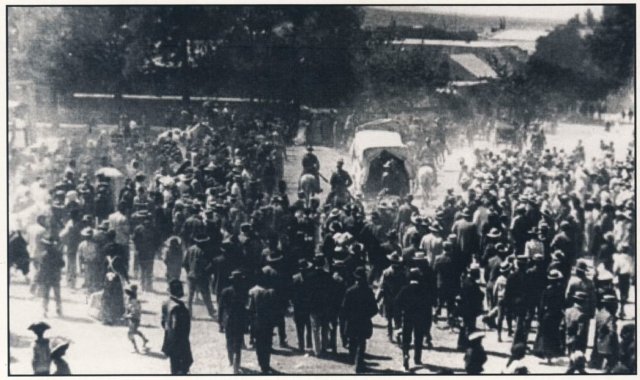
The prisoner is led away after receiving
the death sentence on 17 January 1902
(Photo: E Whitlock’s Collection).
Scheepers refuted all charges against him. As regards his treatment of prisoners, Scheepers said that he had handled them with the greatest respect; he had captured over 1 300 and had received letters from British officers thanking him for his kind treatment.
Cross-examined on 28 December 1901, Scheepers stated that, when he had surrendered on 10 October 1901, he wrote a letter to the Commandant of Prince Albert to request a doctor. He had been gravely ill at the time and could not move.
He also said that he was unaware that the British had issued a proclamation that the shooting of a black person would be regarded as murder. When he received Commandant Kritzinger’s orders not to burn houses, he said he was reminded of the Orange Free State proclamation to burn houses and was awaiting a reply. He stated that he was following instructions and not burning houses for the sake of revenge (Shearing, 1999, p161). More detail on the course of the trial is well documented in David and Taffy Shearing: Commandant Gideon Scheepers and the search for his grave.
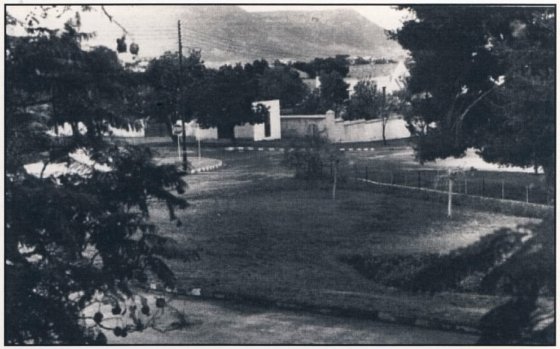
Today, the site where Scheepers officially received the death sentence is
located on the corner of Church and Caledon streets in Graaff-Reinet.
Scheepers was found guilty. His sentence was announced at a parade in Church Square. Members of the Town Guard and Coldstream Guards and the public witnessed the ceremony. At 11:00 Scheepers arrived by ambulance accompanied by a mounted guard. Lt-Col A Henniker read the long list of charges, to which Scheepers had been found guilty of all except one, a charge of murder. The death sentence was pronounced and Scheepers walked back to the ambulance and was transported to gaol (Shearing, 1999, pp167-168).
The sentence
On 18 January 1902 an ambulance wagon transported Scheepers outside Graaff-Reinet to a spot beyond the Sundays River on the road to Murraysburg. He was blindfolded and tied to a chair; an empty hole dug nearby. He was shot by a firing party at 15:00. His body was lowered into the grave and covered with soil. That night, the body was exhumed and then removed to another location. According to Shearing (1999, p151) the grave is now under the waters of the Van Ryneveld dam, although the exact spot is unknown.
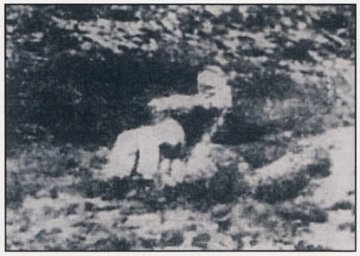
A gruesome image of the execution.
Scheepers, tied to a chair, is thrown
backwards by the impact of the bullets.
(Photo:Taffy & David Shearing).
The monument in Graaff-Reinet
The monument at the corner of Donkin and Somerset streets commemorates the Boers who were executed by firing squad at Graaff-Reinet: P J Fourie, J B L van Rensburg, L F S Pfeiffer, D F Olwagen, I W Nel, J H Roux, Kommandant G J Scheepers, and J F Geldenhuys.
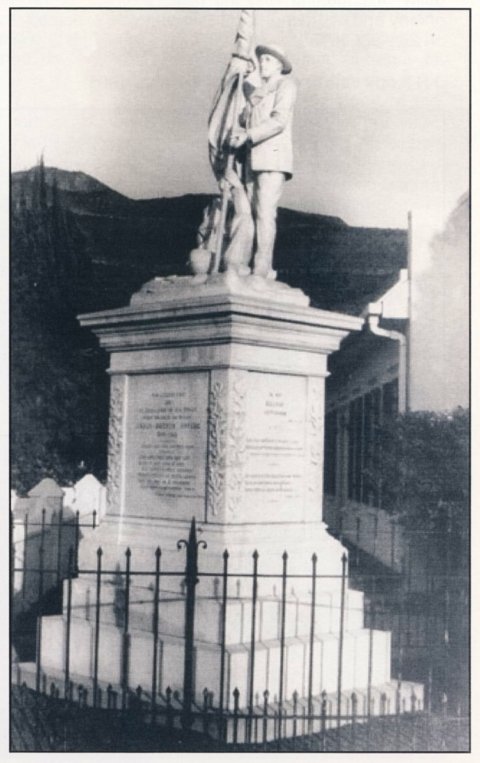
Monument at the corner of Donkin and Somerset streets,
commemorating the Boers who were executed by firing
squad at Graaff-Reinet.
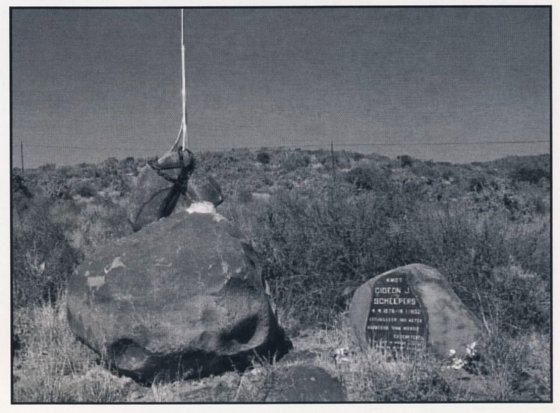
Memorial to Scheepers outside Graaff-Reinet
They died by firing squad
P J Fourie joined Scheepers’ Commando. He was found guilty for murder and arson and executed on 19 August 1901.
J B L van Rensburg joined Scheepers’ commando. He was found guilty for engaging in military action with the enemy and for attempted murder and arson. He was executed on 19 August 1901.
L F S Pfeifer joined Scheepers’ commando. Found guilty on three charges of arson and for having been actively under arms, he was executed on 19 August 1901.
F D F Oldwagen joined Scheepers’ commando. He was found guilty of attempted murder and for engaging with the military forces of the enemy and was executed on 26 August 1901.
I W Nel joined Scheepers’ commando. He was found guilty for engaging with the military forces of the enemy and for attempted murder and was executed on 26 August 1901.
J H Roux was executed on 18 January 1901.
Comdt G J Scheepers was found guilty of murder, numerous counts of arson, and train wrecking. He was executed on 18 January 1902.
J F Geldenhujs was sentenced for high treason and attempted murder and executed on 14 February 1902.
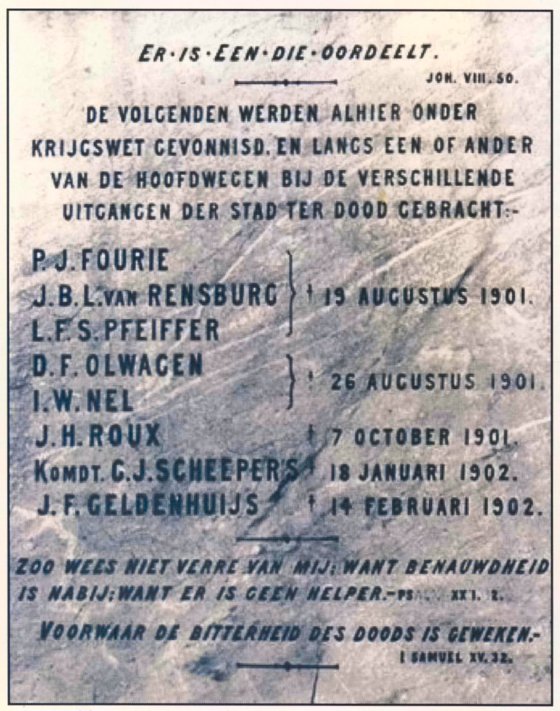
Memorial plaque of the names of the executed men.
Bibliography
Cloete, Pieter G, Die Anglo-Boeroorlog: ’n Chronologie (Flamwood, 2010).
Koch, Retief, Van die oewer van die Dwyka na Graaff-Reinet se sand: Kommandant Gideon Scheepers (Bloemfontein, Private publication, 1998).
Shearing, Taffy and David, Commandant Gideon Scheepers and the search for his grave (Sedgfield, private publication, 1999).
Stirling, John, The Colonials in South Africa, 1899-1902 (Reprint, 1990). Watt, Steve, Roll of Honour Imperial Forces. Anglo Boer War 1899-1902 (Pietemaritzburg, 2000).
The defence of the Cape Colony was entrusted to mainly locally raised units supplemented by several regular units. No fewer than 57 men lost their lives in confrontation with Scheepers’ commando. (Watt, 2000, In Memoriam).
Return to Journal Index OR Society's Home page
South African Military History Society / scribe@samilitaryhistory.org